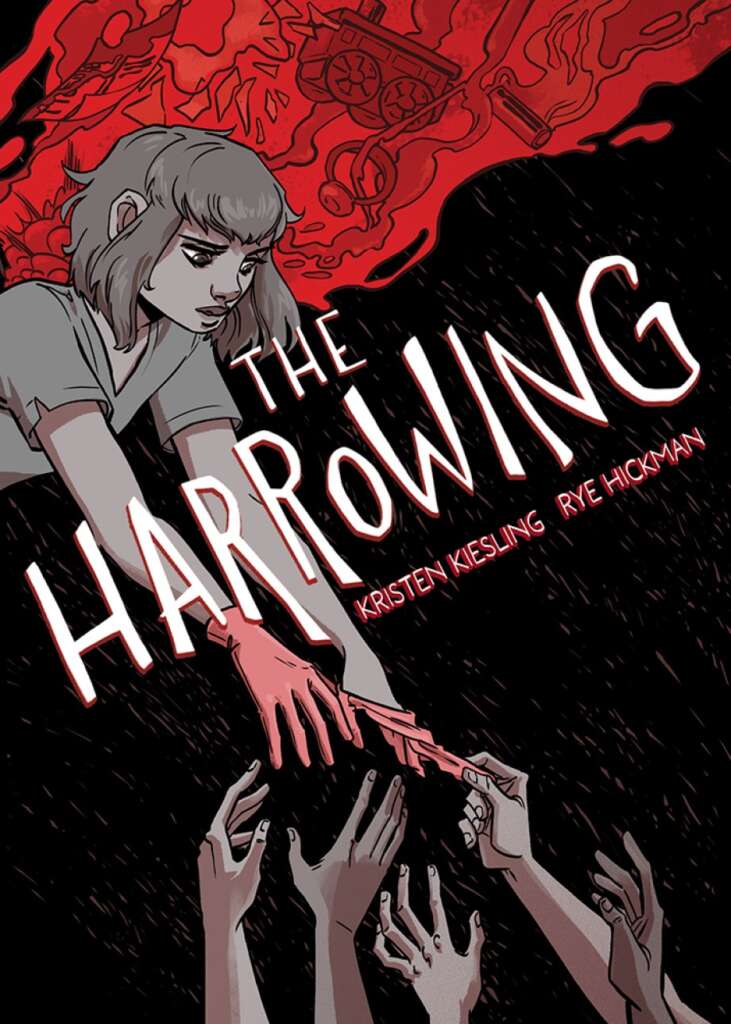REVIEW: The Harrowing by Kristen Kiesling and Rye Hickman

Reviewed by Evelyn Garcia
The Harrowing is an innovative thriller written by Kristen Kiesling and illustrated by Rye Hickman. When a teenage farm girl named Rowan discovers she has psychic powers that give her the ability to see horrifying visions of future murders, her life is turned upside-down. Rowan joins Rosewood, a secret organization dedicated to training Harrows, who are individuals with psychic abilities like her own. Every Harrow is given the responsibility to seek out and find imcrims (imminent criminals), so they can put a stop to future crimes.
Kiesling presents a refreshing take on the hero’s journey, as Rowan isn’t just reluctant to take up the call to adventure, she lacks all interest because her life thus far has been so strongly impacted by tragedy. After her mother’s murder, she does her best to carry on, helping her father on the family farm while taking on a second job working nights at a diner. She appears indifferent, going through the motions of everyday life, having rejected thoughts of going to college and accepted her life on the farm.
But Rowan finds herself waking in a strange facility, her arrival to Rosewood not by choice. Feeling scared and confused about her abilities, she initially rejects becoming a Harrow because the call to adventure is forced upon her. But Jackie and Simon, the Harrows’ trainers, convince Rowan of how effective and important her psychic abilities are in helping people and preventing future tragedies.
Though Jackie and Simon appear to have good intentions, their efforts to bring Rowan onboard demonstrates disregard for Rowan’s discomfort and reminders of her mother’s death. While other heroes might spring into action as soon as they hear pleas for help and, Rowan clearly states a desire to go home. Jackie and Simon’s tactics are pushy and manipulative. Yet, after seeing what pain others have endured, Rowan feels guilty and is convinced to join the organization despite feeling unsure of her decision.
Heroes typically have a goal that drives them towards the adventure—something that is meaningful to them and will help them make sense of their circumstances and grow. Rowan, however, has no clear-cut motivation. At the beginning of the story, both Rowan and her father are stuck in a trauma cycle. Her father doesn’t encourage her to get out into the world and find her purpose, and they both have become content and comfortable in the mundane routine life on the farm. Rosewood was a way out of Rowan’s routine, but the Harrows’ goals are not her own.
Though the trauma of losing her mother inspires her to help others avoid similar upheaval, Rowan second guesses the organization’s goals when she is torn by two different perspectives. Carly, her quirky and cheerful roommate, believes in the organization’s desire to help people and that Rosewood has good intentions in doing what’s best for the greater good. She acts as a voice of faith, reassuring Rowan to trust the organization and people who want to help and change the world for the better. Having received help from Rosewood in the past, Carly doesn’t further question Rosewood’s motives.
On the other hand, Sam, Rowan’s reserved and cautious friend, questions Rosewood and suspects shady plans are happening behind the scenes. She is the voice of reason, a more logical and critical observer, not swayed by positive bias like Carly. Rowan understands these different views, having initially leaned towards Carly’s positive framing while sharing Sam’s lingering suspicions. It’s not until Rowan sees a vision of someone she knows well and cares about that she believes Rosewood is capable of doing horrific things. Rowan realizes that there could be more to the story behind her visions. She develops her own goals only at the climax, suggesting a series of Harrowing books to come.
The novel deals with dark themes, and its visual tone is somber. Violence and tragedy are conveyed through bold and sketchy line strokes and monochromatic colors that shift with the mood. Memories are represented in lighter blue colors in order to understand whose memories are being represented. Hickman’s masterful incorporation of color is particularly noticeable when Rowan and other Harrows use their psychic abilities to see visions that occur only with individuals who have red or black auras. More prevalent to the story are imcrims with red auras, indicating unplanned murders committed out of passion. Different shades of red permeate the novel to foreshadow danger or to portray an event of violence. For instance, when one person touches Rowan’s hand, Rowan envisions an accident colored in red to indicate that this person is an imcrim who will commit a crime in the future.
The one drawback to this use of symbolic color, however, is that it can lead to overuse. Though red draws focus to important actions or items, it is also used in scenes where no violence is taking place and has nothing to do with Rowan’s visions: a red line or two to indicate motion when bumping into someone with no red aura, a head motion or a slight movement when there is no danger or great importance to the action. This decreases the impact of color, though overall it helps to draw the viewer’s attention to specific scenes and makes the scenes pop.
The Harrowing is a supernatural superhero origin story that deals with dark themes while maintaining a sense of realism. With its reluctant hero, compelling visuals, and stylish color-coding, the graphic novel is experienced like a film. It is an exciting, gripping thriller that explores, through the lens of newfound psychic powers, how heroism can emerge from hardship and help trauma survivors like Rowan find purpose.
Evelyn Garcia is currently a student at the University of California Riverside in Palm Desert. She is in the Low Residency MFA Program for Creative Writing, studying fiction and screenwriting.
